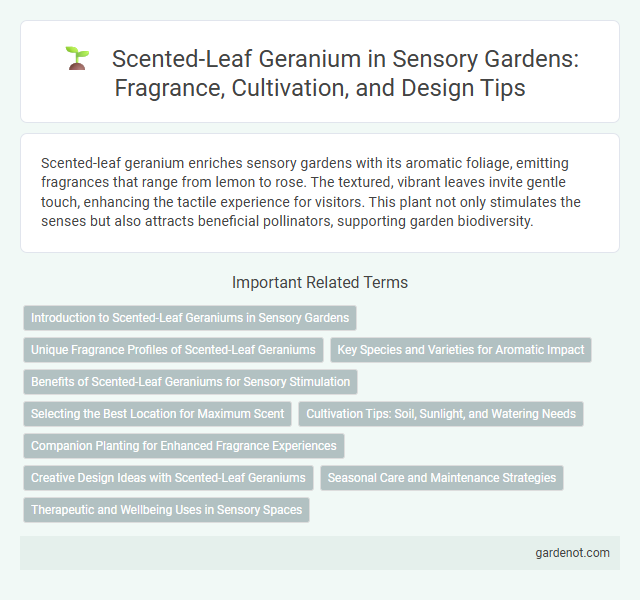Scented-leaf geranium enriches sensory gardens with its aromatic foliage, emitting fragrances that range from lemon to rose. The textured, vibrant leaves invite gentle touch, enhancing the tactile experience for visitors. This plant not only stimulates the senses but also attracts beneficial pollinators, supporting garden biodiversity.
Introduction to Scented-Leaf Geraniums in Sensory Gardens
Scented-leaf geraniums in sensory gardens offer a unique aromatic experience with their vibrant foliage emitting distinct fragrances such as rose, lemon, or mint. These plants enhance sensory engagement by stimulating the olfactory senses, making them ideal for therapeutic and educational garden spaces. Their easy maintenance and varied scents contribute to the garden's multi-sensory appeal, encouraging exploration and connection with nature.
Unique Fragrance Profiles of Scented-Leaf Geraniums
Scented-leaf geraniums exhibit a diverse range of unique fragrance profiles, including rose, lemon, peppermint, and even spicy cinnamon scents, making them a sensory delight in any garden setting. The essential oils contained in their leaves release aroma when touched or brushed, enhancing the sensory garden experience through olfactory stimulation. These varying fragrances attract pollinators and contribute to natural pest control, enriching the garden's ecological balance.
Key Species and Varieties for Aromatic Impact
Scented-leaf geranium (Pelargonium spp.) is a key species in sensory gardens, known for its diverse aromatic profiles ranging from rose and lemon to mint and spice. Popular varieties such as Pelargonium 'Citrosum', 'Graveolens', and 'Lemon Fizz' are prized for their distinct and intense fragrances that enhance olfactory stimulation. Cultivating these aromatic geraniums contributes to a multisensory experience, promoting relaxation and therapeutic benefits in designed garden spaces.
Benefits of Scented-Leaf Geraniums for Sensory Stimulation
Scented-leaf geraniums enhance sensory gardens by providing strong, aromatic foliage that stimulates the olfactory senses and encourages mindfulness. Their varied scents, ranging from lemon to rose, offer therapeutic benefits such as stress relief and mood enhancement. These plants also support tactile interaction with their textured leaves, enriching overall sensory engagement.
Selecting the Best Location for Maximum Scent
Scented-leaf geranium thrives in well-drained soil with full sun exposure to intensify its fragrant oils, enhancing the garden's sensory experience. Positioning the plant near pathways or seating areas ensures that its aromatic leaves are easily brushed or touched, releasing the maximum scent. Avoid shaded or humid spots as these conditions can diminish the strength and longevity of the plant's fragrance.
Cultivation Tips: Soil, Sunlight, and Watering Needs
Scented-leaf geranium thrives in well-draining, moderately fertile soil with a pH between 6.0 and 7.0, ensuring optimal root health. This plant requires full sun to partial shade, receiving at least six hours of direct sunlight daily for robust aromatic foliage. Water the geranium consistently, allowing the top inch of soil to dry out between waterings to prevent root rot and promote vigorous growth.
Companion Planting for Enhanced Fragrance Experiences
Scented-leaf geranium (Pelargonium spp.) enriches sensory gardens by emitting diverse fragrances that complement nearby aromatic herbs like lavender and rosemary, intensifying the overall olfactory appeal. Its companion planting with flowering plants such as marigolds promotes natural pest control, enhancing plant health and fragrance longevity. Combining scented-leaf geranium with mint and basil creates layered scent profiles, elevating visitor experiences through dynamic and harmonious aroma blends.
Creative Design Ideas with Scented-Leaf Geraniums
Incorporate scented-leaf geraniums in sensory gardens by combining their aromatic foliage with contrasting textures like soft lamb's ear or feathery ornamental grasses to create visually and tactilely engaging plots. Use varying shades of geranium leaves, from deep purples to bright greens, to add dynamic color layers that enhance garden pathways and seating areas. Position these plants near walkways and interactive zones to maximize their fragrance impact, enriching the sensory experience for visitors through scent-triggered memory stimulation and relaxation.
Seasonal Care and Maintenance Strategies
Scented-leaf geranium thrives with regular pruning after flowering to maintain its shape and encourage bushy growth. Apply balanced fertilizer during spring and summer for optimal leaf fragrance and vibrant foliage. Protect the plant from frost by moving containers indoors or using mulch to insulate roots throughout colder months.
Therapeutic and Wellbeing Uses in Sensory Spaces
Scented-leaf geranium enhances sensory gardens with its aromatic foliage known for stress-relief and mood-lifting properties. The essential oils in the leaves promote relaxation and help reduce anxiety, making it ideal for therapeutic environments and wellbeing-focused sensory spaces. Incorporating scented-leaf geranium supports mental clarity and emotional balance through natural aromatherapy benefits.
Scented-leaf geranium Infographic

 gardenot.com
gardenot.com